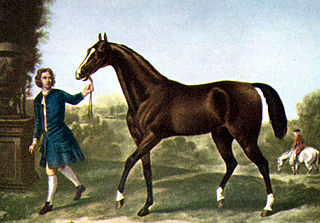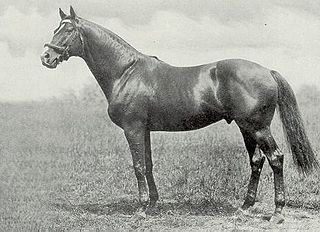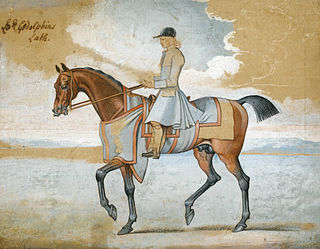
The Darley Arabian was one of three dominant foundation sires of modern Thoroughbred horse racing bloodstock. The other two founders were the Godolphin Arabian and the Byerley Turk. This bay Arabian horse was bought in Aleppo, Syria, by Thomas Darley in 1704 and shipped to Aldby Park in England, as a present for his brother.

The Godolphin Arabian, also known as the Godolphin Barb, was an Arabian horse who was one of three stallions that founded the modern Thoroughbred. He was named after his best-known owner, Francis Godolphin, 2nd Earl of Godolphin.

A grimalkin, also known as a greymalkin, is an archaic term for a cat. The term stems from "grey" plus "malkin", an archaic term with several meanings derived from a hypocoristic form of the female name Maud. Scottish legend makes reference to the grimalkin as a faery cat that dwells in the highlands.

Precipitation was an influential British-bred Thoroughbred stallion who is found in the pedigrees of many racehorses and sport horses today. He is responsible for helping maintain the Matchem sireline through his son, Sheshoon.

Matchem, sometimes styled as Match 'em, was a Thoroughbred racehorse who had a great influence on the breed, and was the earliest of three 18th century stallions that produced the Thoroughbred sire-lines of today, in addition to Eclipse and Herod. He was the Leading sire in Great Britain and Ireland from 1772 - 1774.

Cade (1734–1756) was an important foundation sire of Thoroughbred racehorses. He was the Leading sire in Great Britain and Ireland in 1752, 1753, 1758, 1759 and 1760.

Sir Peter Teazle was a good British bred Thoroughbred racehorse, a Leading sire in Great Britain & Ireland nine times, and carried on the sire line of Herod.

Highflyer was an undefeated Thoroughbred racehorse and a very successful sire of the 18th century.

Hurry On was an undefeated British Thoroughbred racehorse and sire that revived the Matchem sire line. English trainer Fred Darling called Hurry On the best horse he ever trained.
Selima was one of the most important Thoroughbred horses of the 18th century and became one of the foundation mares of the American Thoroughbred. She was imported to Maryland between 1750 and 1752 by Benjamin Tasker, Jr.
King of the Wind is a 1990 British adventure film directed by Peter Duffell and starring Richard Harris, Glenda Jackson and Frank Finlay. It is based on the novel King of the Wind by Marguerite Henry. The film depicts the life of the Godolphin Arabian, an Arab colt in 18th-century Kingdom of Great Britain.

Skyscraper (1786–1807) was a British Thoroughbred racehorse. One of many notable offspring of the great Highflyer, Skyscraper is best known for winning The Derby of 1789. He competed until he was seven, when after losing two races he was retired to stud.
Curwen's Bay Barb was a foundation sire of the Thoroughbred breed. A bay horse with a white blaze, he was imported by Henry Curwen in 1698 from France. He had originally been a present to Louis XIV from the King of Morocco. One of his early sons, Mixbury, stood just over 13 hands high and apparently "there were not more that two horses of his day that could beat him under light wrights". He also sired Tantivy, Brocklesby, Brocklesby Betty, Creeping Molly and the top stallion Hip. It has also been suggested that he may have been the sire of Alcock's Arabian.
Blank (1740–1770) was a British Thoroughbred racehorse and sire. He only won one race, but became a very successful sire and was British Champion sire in 1762, 1764 and 1770.

Soothsayer (1808–1827) was a British Thoroughbred racehorse and sire best known for winning the classic St Leger Stakes in 1811. Bred and originally trained in Yorkshire he won the St Leger on his third racecourse appearance when still unnamed. He was later sold and trained for the remainder of his racing career at Newmarket where he won a valuable sweepstakes in 1812 and a match race against the Derby winner Phantom in 1813. He later became a successful breeding stallion, siring two classic winners and being the Leading sire in Great Britain and Ireland in 1819. He was later exported to Russia where he died in 1827.
Hollandoise, or alternatively Hollandaise, (1775–1782) was a grey British Thoroughbred mare that won the 1778 St. Leger Stakes, the first horse to win the event under its formal title. Raced sporadically from 1778 to 1782, Hollandoise won eight races in 14 starts. She died suddenly shortly after her last race in 1782 before producing any offspring.
Young Traveller was a British Thoroughbred racehorse best known for winning the classic St Leger Stakes in 1791. Bred and originally campaigned in Yorkshire he won two of his three races as an unnamed three-year-old in 1791. On the day after his classic victory he defeated an unusually strong field of older horse to become the first St Leger winner to also win the Doncaster Cup. In the following year he was sold, renamed and raced mainly in Scotland, winning a further five races before the end of his racing career. Young Traveller does not appear to have been used as a breeding stallion.

Lath was a British Thoroughbred racehorse. He won at least four races, including a 1000-guinea sweepstakes at Newmarket and a match race against Squirt. After retiring from racing he became a stallion and produced a number of high-class runners and also sired the grand-dam of St. Leger winner Hollandoise.
Why Hurry was a British Thoroughbred racehorse and broodmare, who raced during World War II and was best known for winning the classic Oaks Stakes in 1943. After winning one minor race as a juvenile she finished fifth in the 1000 Guineas before winning the Oaks, run that year on the July Course at Newmarket Racecourse. After finishing unplaced in the St Leger she was retired from racing and had some success as a broodmare.
Australian was a British-bred Thoroughbred racehorse and sire. He was exported to the United States where he had modest success as a racehorse but became a very successful and influential breeding stallion.












